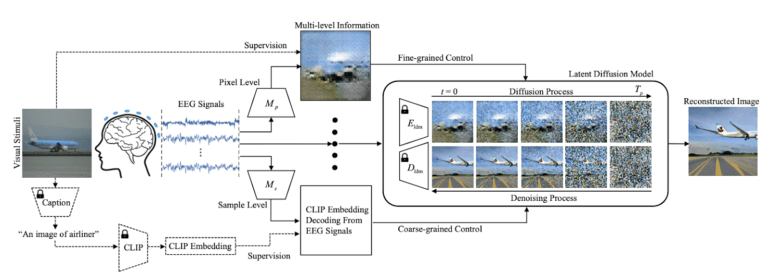TL;DR:
- The human brain’s response to visual stimuli holds the key to understanding cognition.
- NeuroImageGen uses EEG signals for efficient image reconstruction.
- Diffusion models enhance EEG-based image reconstruction by sidestepping pixel-based limitations.
- Multi-level semantics extraction module deciphers pixel-level and sample-level information.
- Promising results outperform traditional EEG-based image reconstruction methods.
- NeuroImageGen advances our understanding of the impact of visual stimuli on the human brain.
Main AI News:
The human brain, a remarkable enigma of our biology, holds the key to unraveling the mysteries of life itself. Questions about how we think, perceive, and act find their answers in the intricate workings of this extraordinary organ. Among the myriad of questions, understanding how the brain responds to visual stimuli stands at the forefront of contemporary research. Delving into this domain could pave the way for the development of advanced computational cognitive systems, and recent advancements in neuroimaging technologies are bringing us closer to this goal.
Functional magnetic resonance imaging (fMRI) and electroencephalography (EEG) are our lenses into the brain’s activity in response to visual input. With these powerful tools, scientists have embarked on a quest to decode and reconstruct the actual content that triggers neuronal responses in the human brain. While the traditional approach primarily relies on fMRI data, it comes with significant drawbacks, such as high costs and participant discomfort within the confines of the MRI machine.
This is where EEG takes center stage. EEG, although not without its own challenges, offers a more efficient means to record and analyze brain signals as subjects engage with various visual stimuli. Yet, EEG signals present a unique complexity as time-series data, making it challenging to map these signals to specific visual stimuli accurately. Moreover, issues like electrode misplacement and subject motion introduce noise that complicates the process further.
Enter diffusion models, the cutting-edge approach in generative modeling. These models, operating within the latent space of potent autoencoders, have revolutionized various tasks, from image synthesis to video generation. By sidestepping the limitations of pixel-based evaluation, diffusion models offer faster inference and reduced training costs, making them a promising avenue for EEG-based image reconstruction.
Allow us to introduce you to NeuroImageGen, a groundbreaking solution that harnesses the power of diffusion models to address the intricacies of EEG-based image reconstruction. NeuroImageGen incorporates a multi-level semantics extraction module, which deciphers varying levels of semantic information from EEG signals. This module spans the gamut from capturing pixel-level details like color, position, and shape through saliency maps to recognizing image categories and text captions at a more abstract, sample-level semantics.
The complexity of EEG signals, fraught with noise, becomes manageable with NeuroImageGen’s multi-level semantics approach. It empowers the system to tackle the challenge effectively, resulting in high-quality visual stimulus reconstruction. Pixel-level semantics, represented by saliency maps derived from EEG features, form the foundation of the initial image. Sample-level semantics, in the form of CLIP model embeddings of image captions, guide the denoising process within the diffusion model. This synergy of multi-level semantics allows precise control over the reconstruction process, culminating in visually stunning outcomes that blend fine-grained and coarse-grained information seamlessly.
The results achieved through this innovative approach are nothing short of promising. NeuroImageGen outperforms conventional image reconstruction methods when applied to EEG data, significantly enhancing structural similarity and semantic accuracy in the reconstructed images. This breakthrough promises to deepen our understanding of how visual stimuli impact the human brain, opening doors to a new realm of cognitive exploration and innovation.
Conclusion:
NeuroImageGen’s innovative approach to EEG-powered visual stimulus decoding, leveraging diffusion models and multi-level semantics extraction, marks a significant breakthrough in cognitive research. This advancement not only enhances our understanding of the human brain but also opens doors for practical applications in industries like healthcare, entertainment, and education, where precise control over visual stimuli’s impact is of utmost importance. The market can anticipate increased demand for EEG-based cognitive research solutions and potentially disruptive innovations in these sectors.

